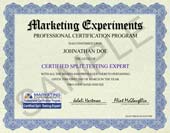NOTES:
To view the notes as they are added, please refresh this page when instructed to do so.
Business Success Potential:
S = 2V + C + P
Where:
S is the probability that the business will Succeed.
V is the Value proposition.
C is the marketing Channel and the amount of cost-effective traffic that is available from this Channel.
P is the Presentation of your offer and website, and your ability to optimize this Presentation.
Value Propositions (1-5 Scale):
[0 – No real value proposition (a full-price retail product that can be bought anywhere).]
1 – Limited value to a small market. There is extensive competition and/or few barriers to entry.
2 – Substantial value to a medium-sized market. There is limited competition and/or significant barriers to entry.
3 – A product or service with strong product differentiation, but little competitive protection.
4 – A unique product or service that is highly valuable to a large market, and strong competitive protection and/or extensive barriers to entry. This may take the form of a registered patent or limited access to product components.
5 – A unique product or service that is highly valuable to a large market, and exclusive or near-exclusive control of essential product components. This may also include a registered patent.
| Value Propositions | |
|---|---|
| Metric | Total |
| VP Index 1 | 22 |
| VP Index 2 | 215 |
| VP Index 3 | 32 |
| VP Index 4 | 6 |
| VP Index 5 | 0 |
Force of Value Proposition:
VF = NA – CT
Where:
VF is Value Proposition Force
NA is Natural Appeal
CT is Competitive Threat
“Discovering” a Value Proposition:
- A value proposition is not usually determined, it is discovered. It grows out of need. If you set out to create the “best possible business,” you may or may not end up with a great business. If you set out to solve the needs of your customers, your business will naturally evolve into something valuable.
- Avoid a sales-driven approach to product development. You should develop products for the market. A taxi driver drives around looking for fares. Microsoft researches the market and the competition and develops products years in advance.
- Refine your value proposition until you can articulate it in one sentence. You should be able to communicate who your customers are, what you provide to them, and why they buy from you.
For example, even though this company may serve a smaller market, it has a better chance of being successful:
“XYZ Corp is the exclusive provider of patent-pending project management software for paving contractors, saving U.S. contractors over $34M in 2005.”
Than this company:
“ABC Corp is the premier B2B portal for small businesses looking to grow.”
- Ask yourself why someone should buy from you instead of a competitor. If your answer is “best selection,” “best customer service,” or “fast shipping,” you potential success may be quite limited. These qualities do not make a business unique.
- The simple ideas are the easiest to execute. Google’s idea was to “be the best search engine.” They succeeded because, even though there was competition, they did create the most useful search engine. It produced the most relevant results and was clear from clutter and ads.
When Google said they were the best search engine, that statement in itself was no guarantee that they had a strong value proposition. Every other search engine was saying the same thing.
The difference is that Google IS the best search engine.
This is a key issue with a value proposition. It has to be what you DO and ARE. It can’t be just what you SAY or WANT.
All too often companies write value propositions and mission statements that attempt to cover up the cracks in their actual business… with words.
That doesn’t work. Your value proposition is not what you say… it is what you are.
Finalists: Back-of-a-Napkin Business Plan Contest:
S. Brink
Clinical Trial TestingM. Tsai
Online Community building
D. Garland
Business Marketplace
P. Hankinson
Networked CPU Power
S. Wolf
Online Publishing
D. Chapman
Online Community Building
John
Low Budget Film Production
B. Sowerby
3rd World Aids Detection
L. Starr
Marketplace for Film Production
W. Michel
Local Comparison Search
E. Dugan
Online Wish Lists
R. Trible
Brand Development for 2nd Tier Products
M. Wyman
Category Specific Dating Site
D. Massey
Online Dispute Resolution
D. Smith
Online Boat Graphics
F. Ibanez
Affiliate Program Software
Duy
Document Storage
S. Gordon
Super Affliliate Corp
Aldi
Mobile Social Networking
R. Valentine
Do-it-yourself Realtor
P. Kumar
Medical Research
G. Gooch
Cell Phone Based Auction Tool
R. DiBenardo
Online Hairdressing Community
D. Douglass
P2P Cartoonist Network
Eric
Adsense for Blogs
M. Madden
Career Marketplace
H. Gilliam
Online Community
T. Kendall
Online Book Publishing
Anonymous
Secure Document Storage
P. Lipetz
Online TV Broadcasts
J. Tokarz
Search Engine
R. Bradshaw
GPS Technology
G. Piazza
Component Miniaturization
M. Reall
Software Outsourcing Management
T. Tweedy
Word of Mouth Marketing
J. Jocke
Calendar System
 Learn from the MEC Research Team How to Test and Optimize Your Website
Learn from the MEC Research Team How to Test and Optimize Your Website
Become A Certified Online Testing Expert With the Marketing Experiments Professional Certification Program. Register today for classes starting April 13, 2006.
URLs:


